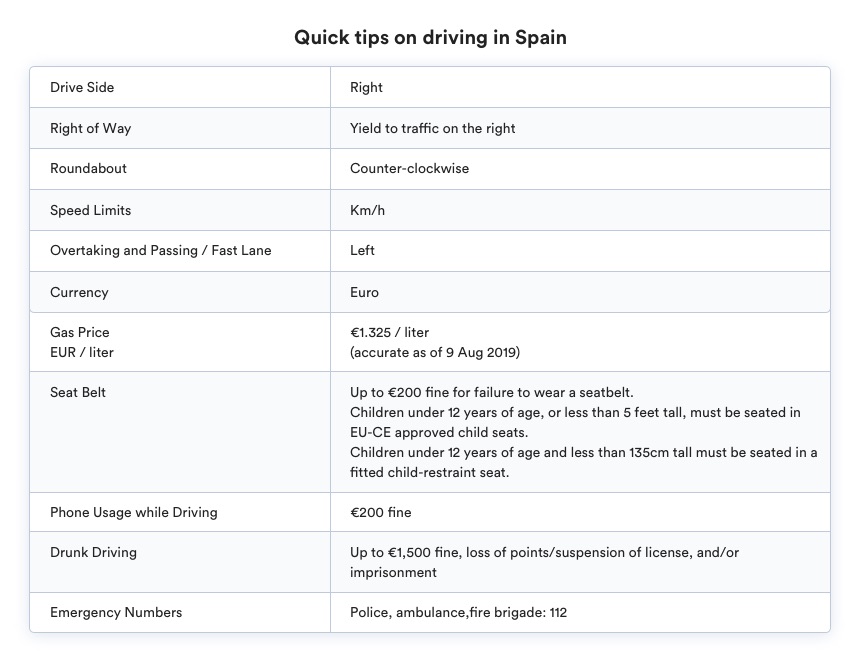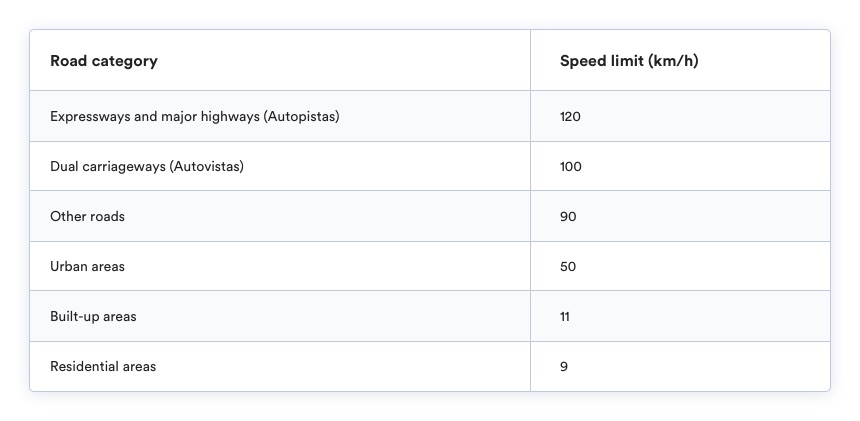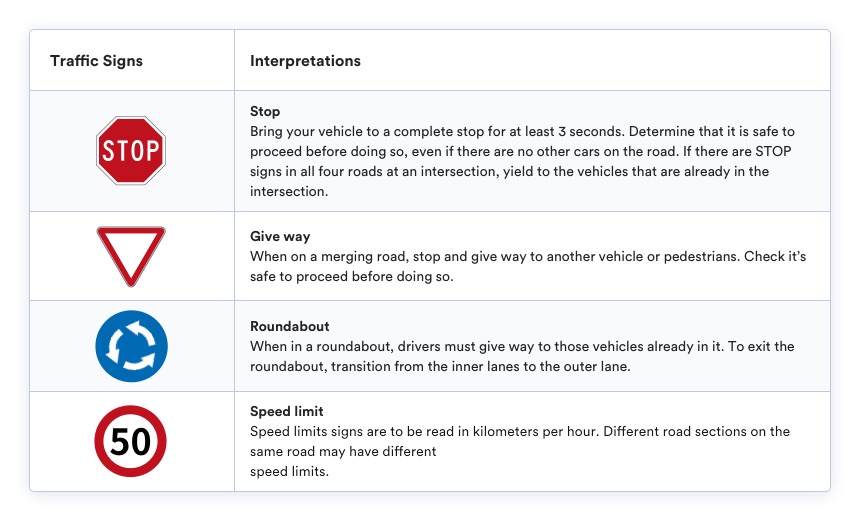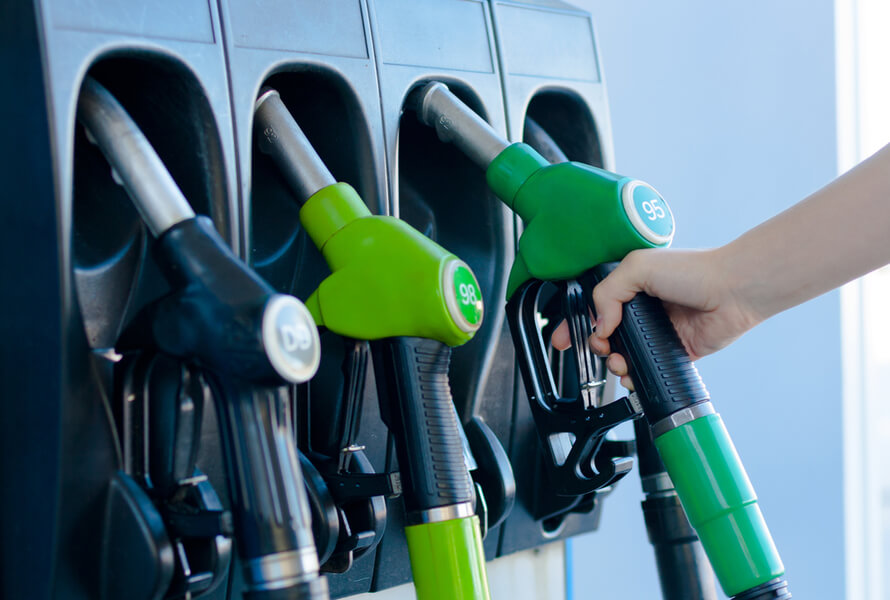The Spanish have a reputation for being aggressive drivers. However, as long as you drive sensibly and follow the rules of the road, driving in Spain is incredibly safe and enjoyable. If you are looking to hire a car in Spain, you’ve come to the right place! Let’s start with some quick facts on driving in Spain:
1. Driving Rules and Tips
- Speed Limits
For starters, there is an abundance of speed cameras in Spain. Be aware that exceeding posted speed limits is punishable by a fine of up to €600 or even imprisonment of up to 4 years.
Secondly, speed limits will vary depending on the type of road on which you are driving. The following table highlights the speed limits on the most common road categories in Spain:
Expert tips: Look out for speed limit signs – it can be easy to forget them, especially when you are embarking on a cross-country journey. In addition, adjust your speed according to the weather and road conditions.
- Traffic and Road Signs
For more information about Spanish road signs, here is an infographic from QEEQ.COM.
- Driving Tips Specific to Spain
Always remember to indicate when changing lanes on Spanish motorways, or you may risk incurring a fine.
In accordance with Spanish law, all drivers must have at least one high-visibility, fluorescent jacket, and two warning triangles with them at all times. Make sure your car rental company provides you with this.
To get real-time updates on road conditions in Spain, visit this website.
2. Road Conditions and Driving Style
- Road Conditions
With lots of room and little traffic on them, driving on Spain’s roads are a pleasant experience. Not only are the main roads and highways very well-maintained and well-marked, but even roads connecting smaller towns and villages are extremely well-built. However, some rural towns have narrow mountain roads which can be difficult to navigate – exercise greater caution when driving on them.
There are many historical cities in Spain. Due to laws and regulations which protect the city and its roads from extensive infrastructure work, the roads can be narrow and unstable. Drive at a reasonable speed when in these areas.
- Driving Style
When driving in Spain, expect there to be some tailgating and aggressive driving around you. It is not uncommon for local drivers to speed past lights just before they turn red. In addition, car horns can only be used in cases of emergencies – using it in any other situation may result in a fine of up to €60!
Expert tips: When driving on an Autopista, cars may flash you to indicate that they are about to overtake you.
3. Toll Road
Spanish highways are divided into Autopistas and Autovias. Autovias are untolled, and many, but not all Autopistas, are tolled. Both highways have at least two lanes in each direction.
Toll roads are marked by signs that include the letter ‘P’ after the road type. For example, A-42 is an untolled road, while A-41 is tolled.
How to pay
There are several different ways to pay at the toll. Cash and credit cards may be used for the payment of tolls.
Perhaps the most convenient method of payment is the VIA-T electronic payment system. Your rental company may offer this option – check with them before renting the car.
Expert tips: If you are unsure about how to use the payment channels, don’t panic! There is a button next to the electronic toll channel to call the staff for assistance.
4. Gas
The oil at the Spanish gas station is generally divided into gasoline Gasolina and diesel Gasoleo. The 3 main types of gas in Spain are:
- Sin Plomo 95 = Regular Unleaded
- Sin Plomo 98 = Premium Unleaded
- Gasóleo = Diesel
Diesel guns are generally black and gasoline is generally green. If you do not recognize the oil gun, you can consult other drivers or gas station attendants for help.
How to pay
At the pump, there will be a large electronic display showing the prices. Credit cards can be used in most gas stations. However, It is recommended to carry cash with you, because some gas stations may only accept EU-based debit and credit cards. When in doubt, you should approach the gas station attendant during operation hours for assistance. Typically – for security reasons – you will be required to pay for the gas before filling up your car.
Expert tips: Always lock your car doors when filling up your car – there have been cases where cars have been stolen when the driver has left their vehicle unattended at the forecourts.
5. Parking
Most big Spanish cities such as Barcelona and Madrid, usually have free public parking lots around shopping malls and supermarkets.
However, when traveling you are most likely to be parking on the streets. Street parking in most Spanish cities and towns is divided into 3 main zones: white, blue and green zones. Familiarize yourself with these zones so you know where you are allowed to park, and which places you should stay clear of to avoid fines.
- White zone: Free parking zones
- Blue zone: Paid parking zones, indicated by parking meters or ticket machines. Typically there will be a time limit of up to 4 hours, and no overnight parking is allowed.
- Green zone: Resident parking zones. You will need proof of residence to obtain a parking permit to park in this zone. Do not park here unless you have satisfied these requirements, or your car may be towed.
Expert tips: When parking in smaller towns or villages, parking may be harder to find. It is advised that you find an area on the outskirts of the village.
How to pay
Ticket machines can be found in parking locations. Most accept credit card payment, but some only accept coins, so always keep some on you at all times. Once you have purchased a ticket, place it on your windscreen where it is clearly visible to a parking attendant.
Parking costs are normally cost up to €1 per hour, depending on your location. As with the blue zone, there may be a time limit on parking. If you have exceeded your parking time limit, you may receive a fine up to €40 or more. However, in some cases, you may be able to negate this by purchasing another ticket within a certain time limit.
Expert tips: It is usually free to park on Sundays, as well as Monday to Friday, from 2 pm to 4 pm, so take advantage of this when you are traveling!
6. Ending
Above all else, remember to always drive safely and responsibly. Never exceed the posted speed limits, and always have your license, insurance documentation and ID on hand in case an accident occurs.
With everything, you need to know about driving in Spain under your belt, wish you a pleasant journey!
Visit QEEQ.COM now.
QEEQ.COM guarantees the most competitive car rental deals for your travel and the secret is our Price Drop Protector program! We can automatically track your rental rates and RE-BOOK you if prices drop! See how our customers love this feature here.
Interested in discovering more of the Spain? Find more about renting a car here:






